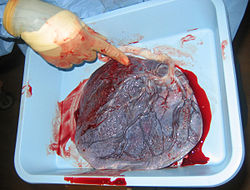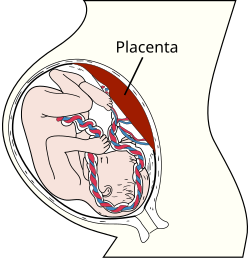Eating the placenta: Is it healthy for new mothers?
The placenta is an organ that connects the developing fetus to the uterine wall to allow nutrient uptake, waste elimination, and gas exchange via the mother's blood supply.
Placenta , after birth
If you have ever had the pleasure of watching an animal, such as a cow, dog or cat give birth – then you have probably also witnessed the not so pleasurable act of these animals eating their afterbirth. In nature, the birthing mother almost always ingests some or all of the afterbirth. With humans of course, the afterbirth and placenta are collected and sampled and shipped off and most mothers don’t even get to see this part of the childbirth.
Placentophagy
The placenta contains high levels of prostaglandin which stimulates involution (an inward curvature or penetration, or, a shrinking or return to a former size) of the uterus, in effect cleaning the uterus out. The placenta also contains small amounts of oxytocin which eases birth stress and causes the smooth muscles around the mammary cells to contract and eject milk. There is no scientific evidence, however, that eating placenta provides these hormonal effects.

The practice, known as placentophagy, is far from widespread and is received with great skepticism by more traditional medical experts. But among a small but vocal contingent of expectant mothers and proponents, it is strongly believed that the organ created by the woman's body to pass nutrients between mother and fetus and is expelled after birth is rich in chemicals that can help mitigate fluctuations in hormones believed to cause postpartum depression.
In the West, the majority of placentas are dumped in the trash. But the placenta is considered sacred by some cultures. And virtually all mammals, including herbivorous ones, eat their afterbirth. Placentophagy, as it’s called, may be inspired by a new mother’s need for extra nutrients or her desire to erase the trace of her birth in order to throw off predators; there is also a theory that the placenta contains a pain-deadening molecule. Most people are repulsed by the idea of eating their own flesh, particularly an excretion from the vagina. But one person’s gross is another person’s delicious, as we know from the fact that fresh monkey brains, fried roaches and dog scrotum are delicacies in various parts of the world. As anthropologists know, “yuck” is culturally constructed.
According to USA Today, there’s a growing group of women who believe that ingesting their placentas may help stave off postpartum depression.
Placentophagists argue that since most other mammals eat their placentas, humans should too. (For a full list of reasons to chow down, click here.) But critics point out that not all mammals are placenta munchers — and that there are plenty of other reasons, besides mood elevation, that an animal might consume it, including as a source of nutrition or as a pain-prevention method (which would make ingesting it post-birth pointless). What’s more, according to a State University of New York at Buffalo professor who wrote his 1971 doctoral dissertation on the subject, keeping the placenta away from animal mothers didn’t make them depressed or cause them to withdraw from their children.
According to USA Today, there’s a growing group of women who believe that ingesting their placentas may help stave off postpartum depression.
Placentophagists argue that since most other mammals eat their placentas, humans should too. (For a full list of reasons to chow down, click here.) But critics point out that not all mammals are placenta munchers — and that there are plenty of other reasons, besides mood elevation, that an animal might consume it, including as a source of nutrition or as a pain-prevention method (which would make ingesting it post-birth pointless). What’s more, according to a State University of New York at Buffalo professor who wrote his 1971 doctoral dissertation on the subject, keeping the placenta away from animal mothers didn’t make them depressed or cause them to withdraw from their children.
How to eat your Placenta
Check your hospital or birthing center’s policy — before you go into labor. Most hospitals treat the placenta as biohazardous waste and dispose of it along with other medical waste (from needles to blood). If you want to keep yours, you’ll need to arrange that in advance. Check with your practitioner too. If he or she’s not a fan of placentophagy, you could try to find a more accommodating provider or petition for a change in procedure.
Follow safe-prep practices. Once you have your placenta, it’s better to freeze it or cook it right away, since like any “meat,” placenta can spoil. Some new moms hire professional placenta preparers (many midwives now know how to prep placenta, too), who dehydrate the afterbirth, grind the dried meat into a powder, and turn the powder into pills that can be swallowed daily. If you go this route, make sure no other herbs or unknown ingredients are added to the mix. Other mothers with stronger stomachs cut the membranes (the thin layer of tissue) away from the placenta, then cook it like any other type of meat: in stews, spaghetti sauces, chili, or patties. Or you can make a smoothie with frozen placenta.
Monitor yourself. No matter how you decide to dish up your placenta, stop taking the pills or eating the meat if you feel sick after ingesting it. And if you do experience PPD, don’t wait around for the “magic” of the placenta to kick in — talk to your doctor, who may suggest therapy or antidepressants.
Placenta Encapsulation
Placenta is shipped to specialized facilities that turn the placenta into a capsule form, is gaining in popularity. Truth is that placentaphogy (the act of consuming the human placenta) is something that has been used in Chinese medicine since the early 1500′s. And in many cultures, matriarchs actually prepare and cook the placenta in special ways to offer the mother after childbirth. Why, you ask? The placenta is filled with an amazing amount of minerals, vitamins and nutrients. Animals instinctively eat the placenta after because it helps to boost their immune systems after birth, and increases milk production for their young. It is also credited for helping to level surging hormone levels after childbirth which, in humans, often lead to the baby blues.
Questions from the FDA
The practice is raising eyebrows at the U.S. Food and Drug Administration. Spokeswoman Kris Mejia says the FDA considers that some statements on the website are making medical claims and will be looking more carefully into the matter. "Human placental capsules that make treatment claims … must be accompanied by well-designed and controlled clinical studies to support approval/licensure," Mejia wrote in an e-mail.
Yet Western researchers are highly dubious of whether taking placenta pills or, in the case of some more devoted placentophagists, cooking and eating it as a food is of any value to humans. The American College of Obstetricians and Gynecologists declined to comment, but a spokeswoman for the British counterpart, the Royal College of Obstetricians and Gynaecologists, told the BBC last year: "Animals eat their placenta to get nutrition, but when people are already well-nourished, there is no benefit. There is no reason to do it."
Subscribe to:
Comments (Atom)





 Read
Read 